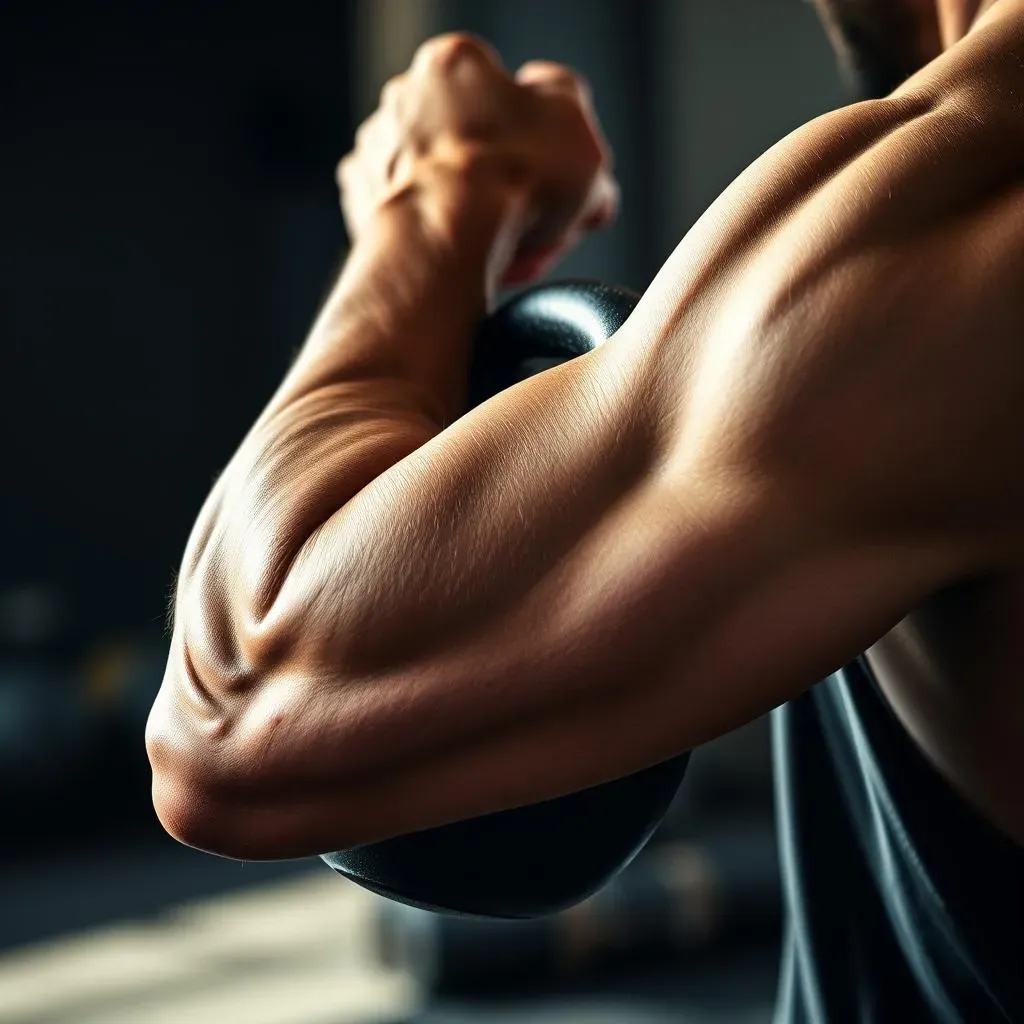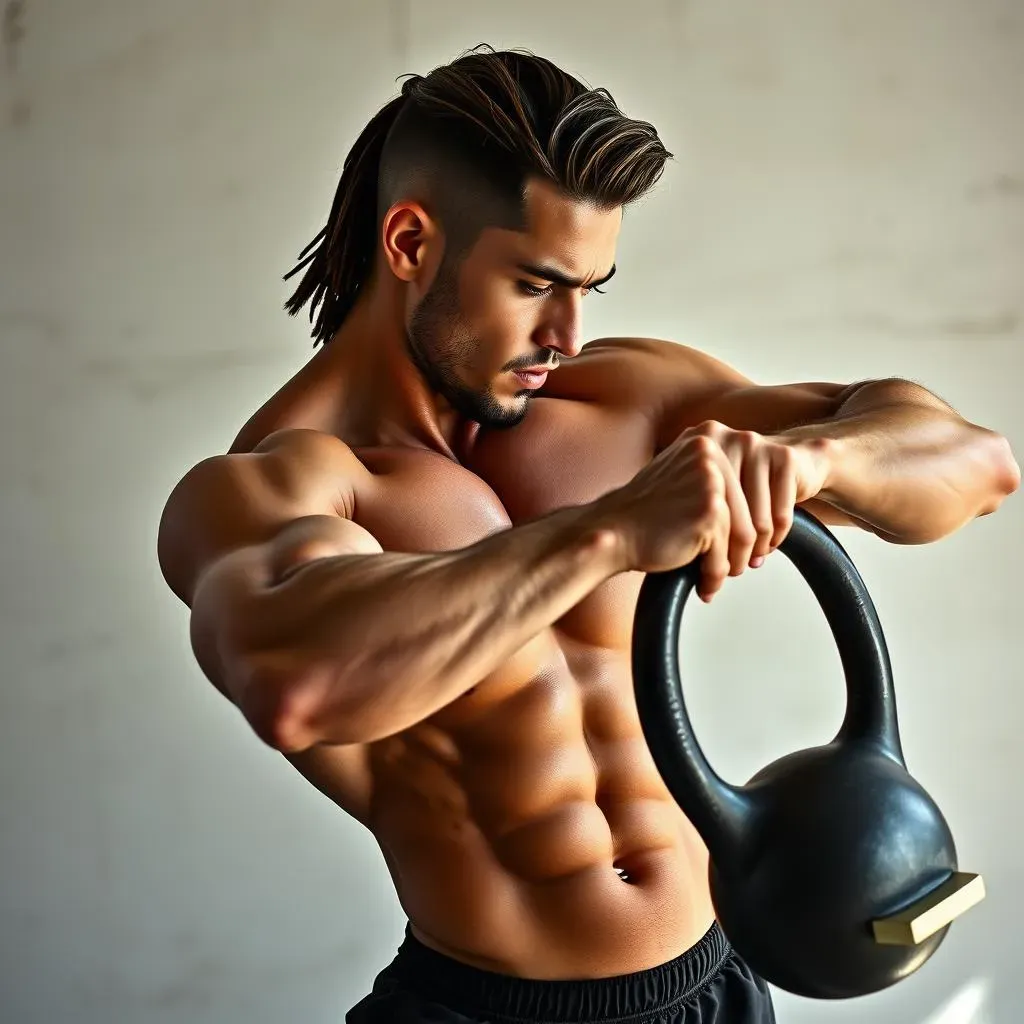Table of Contents
Ever looked at those sculpted arms and wondered how to get them? Forget endless bicep curls with dumbbells; it's time to meet your new best friend: the kettlebell. We're not just talking about swinging weights around; we're talking about a smart, effective way to transform your arms. This article is your guide to mastering the "kettlebell workout arms," and it's not just about looking good, it is about getting strong and functional. We'll explore how kettlebells work differently from traditional weights, focusing on movement, not just muscles. We'll break down the best kettlebell exercises for both your triceps and biceps, plus some awesome combination moves that hit multiple areas at once. Finally, I'll show you how to put it all together into a killer kettlebell arm workout that you can do anywhere. Are you ready to ditch the gym machines and embrace the power of the kettlebell? Let’s get started!
Understanding Kettlebell Training for Arms

Understanding Kettlebell Training for Arms
Kettlebell Basics: More Than Just a Weight
Okay, so you're eyeing the kettlebell, thinking it's just another dumbbell? Think again. Kettlebells are different, and that's a good thing. Unlike dumbbells, where the weight is evenly distributed, a kettlebell's weight hangs below the handle. This changes everything. Instead of isolating muscles, it forces your body to work as a unit, engaging your core and stabilizing muscles. This is key for functional strength, not just show muscles. It means you're not just building bigger biceps; you're building a stronger, more resilient body. It might feel a bit awkward at first, but trust me, this is the secret sauce for real-world strength.
Think about it this way, a dumbbell is like a cup of water, easy to hold and control. A kettlebell is like a bucket of water; it shifts and challenges you as you move. This makes even simple moves like a bicep curl, a full body exercise. You'll find yourself working muscles you didn't even know existed, and that's where the magic of kettlebell training lies. It's not just about lifting; it's about controlling the weight and moving with purpose. So, before we dive into specific exercises, remember that kettlebells are about movement patterns, not just isolated muscle work.
Why Whole-Body Movement Matters
Now, let’s talk about why focusing on movement patterns is so important for your arms. You see, when you grab a kettlebell, you're not just targeting your biceps or triceps. You're engaging your entire body to stabilize and control the weight. This means your core, back, and even your legs are working hard to support every movement. This full-body activation is what makes kettlebell training so effective for building functional strength that translates to everyday life.
For example, when you do a kettlebell swing, you're not just swinging your arms. You’re using your hips and core to generate power, and your arms are just along for the ride. Similarly, when you do a kettlebell press, your whole body works to maintain stability, making it much more than just a shoulder exercise. This interconnectedness is what separates kettlebells from traditional weightlifting. It’s about building strength from the ground up, using your whole body to support your arms, and that’s why it's so effective.
"The kettlebell is the single best tool for developing strength, power, and conditioning. It's the ultimate tool." – Pavel Tsatsouline
Best Kettlebell Exercises for Triceps and Biceps

Best Kettlebell Exercises for Triceps and Biceps
Triceps-Focused Moves: Powering the Back of Your Arms
Alright, let's get to the good stuff, the exercises that'll make your arms pop. First up, we're hitting the triceps, those muscles at the back of your arms. You know, the ones that give you that horseshoe shape? The kettlebell overhead extension is a fantastic move for this. Hold the kettlebell with both hands behind your head, elbows bent, and then extend your arms straight up. It's like you're punching the ceiling, but with a weight. Feel that burn? That's your triceps screaming for more.
Another great option is the kettlebell floor press. Lie on your back with a kettlebell in each hand, and press them up towards the ceiling. This not only targets your triceps but also works your chest and shoulders. It is like a bench press, but with more stability work. Focus on controlling the weight as you lower it, and don't let your elbows flare out too much. Remember, it is all about slow and controlled movement.
Exercise | Primary Muscle | How to Do It |
|---|---|---|
Kettlebell Overhead Extension | Triceps | Hold kettlebell behind head, extend arms up. |
Kettlebell Floor Press | Triceps, Chest | Lie on back, press kettlebells up. |
Biceps-Focused Moves: Sculpting the Front of Your Arms
Now let's talk biceps, the muscles on the front of your arms. The kettlebell bicep curl is a classic, but with a kettlebell twist. Hold the kettlebell with your palm facing up, and curl it towards your shoulder. The offset weight of the kettlebell makes this exercise more challenging than a regular dumbbell curl. You'll find yourself working harder to stabilize the weight, which is a good thing. You can also do hammer curls, where your palms face each other. This hits your biceps and forearms.
Another great bicep exercise is the kettlebell goblet squat with a curl. Hold the kettlebell close to your chest, do a squat, and as you stand up, curl the kettlebell. This combines a lower body exercise with an arm exercise, making it a very efficient movement. This move is also perfect for building overall strength and coordination. Remember to keep your core engaged throughout all the movement, and don't let your back round. Focus on a smooth and controlled motion.
"The key to effective kettlebell training is to focus on proper form and controlled movements. Don't rush through the exercises – feel the muscles working." – Anonymous Trainer
Avoiding Common Mistakes
Before you start swinging kettlebells around like a mad person, let's talk about some common mistakes you should avoid. First, don't use too heavy of a weight. It's better to start light and focus on proper technique than to try to lift too much and risk injury. Remember, it's not about how much you lift, but how well you lift. Second, don't let your back round, especially during exercises like the goblet squat. Keep your core engaged and your back straight. Think of it like you are trying to keep a book balanced on your back.
Third, don't rush through the movements. Control is key with kettlebells. Slow and deliberate movements will help you engage the right muscles and avoid injury. Finally, don't forget to breathe. It seems simple, but it is essential for maintaining proper form and preventing lightheadedness. Inhale as you lower the weight, and exhale as you lift it. These tips will help you get the most out of your kettlebell workouts and keep you safe and healthy.
Effective Kettlebell Combination Exercises for Arms

Effective Kettlebell Combination Exercises for Arms
Why Combination Moves are a Game Changer
Okay, so we've talked about isolated exercises for your triceps and biceps, but let's kick things up a notch. Combination exercises are where the real magic happens. These moves combine multiple exercises into one fluid motion, which means you're not just working your arms; you're engaging your whole body. This is what makes kettlebell training so efficient and effective. It's like hitting multiple birds with one stone, but in a good way! These combo moves not only save time but also boost your calorie burn and improve overall coordination. It's all about working smarter, not harder.
Think of it like this: instead of just doing a bicep curl, you might do a squat and a curl at the same time. This makes your legs, core, and arms work together. This kind of full-body engagement is what makes kettlebell training so powerful. It is not just about building muscles, it is about building a body that is strong and functional. So, get ready to ditch the isolated movements and embrace the power of combination exercises. This is where you will see real progress.
"Compound movements are the foundation of any good strength training program. They not only save time but also give you the most bang for your buck." - Anonymous Fitness Expert
Kettlebell Clean and Press: A Full-Body Powerhouse
One of my favorite combination exercises is the kettlebell clean and press. This move is a powerhouse for your entire body, including your arms. You start with the kettlebell on the ground, then you "clean" it up to your shoulder, and then press it overhead. The clean engages your legs, core, and back, while the press works your shoulders and triceps. This move is not only great for building strength, but also for improving your overall coordination and power. It's a full-body movement that will leave you feeling strong and energized.
When performing the clean and press, focus on generating power from your legs and hips. It's not just about pulling the kettlebell up with your arms; it is about using your whole body to move the weight. Keep your core tight and your back straight, and remember to breathe. This move can be a bit tricky to master at first, but with practice, you'll get the hang of it. Start with a lighter weight and focus on proper technique before progressing to heavier weights. This is a move that is worth investing time into learning.
Exercise | Muscles Worked | Description |
|---|---|---|
Kettlebell Clean and Press | Full body, arms, shoulders | Clean kettlebell to shoulder, then press overhead. |
Kettlebell Squat and Press | Legs, core, arms, shoulders | Squat with kettlebell, then press overhead. |
Kettlebell Squat and Press: Legs and Arms in Harmony
Another fantastic combination exercise is the kettlebell squat and press. This move combines a lower body exercise with an upper body exercise, making it a very efficient way to work your entire body. Hold the kettlebell close to your chest, do a squat, and as you stand up, press the kettlebell overhead. This move not only works your legs and core, but it also engages your shoulders and triceps. It's a great way to build strength and coordination while also burning calories. It is a true all in one move.
When performing the squat and press, make sure to keep your core tight and your back straight. Focus on a smooth and controlled motion, and don't let your back round. The squat should be deep enough to engage your glutes and quads, and the press should be smooth and controlled. Remember to breathe, and don't rush through the movement. This exercise is a great example of how kettlebells can help you work multiple muscle groups at once, saving you time and making your workouts more effective.
Creating Your Own Kettlebell Arm Workout

Creating Your Own Kettlebell Arm Workout
Designing Your Workout: It's All About Balance
Alright, so now you're probably thinking, "Okay, I know some exercises, but how do I actually put them together into a workout?" Don't worry, I've got you covered. The key to a good kettlebell arm workout is balance. You don't want to just focus on biceps or just triceps, you want to hit them both, and also throw in some combination moves for a full body effect. Think of it like creating a recipe; you need a good mix of ingredients to make it delicious. Start by selecting 2-3 exercises for your triceps, 2-3 for your biceps, and then 2-3 combination exercises. This will give you a well-rounded workout that targets all the important muscles in your arms.
Another important thing to consider is the number of sets and reps you're going to do. For strength, aim for 3-4 sets of 8-12 reps. For endurance, you can increase the reps to 12-15. And don't forget about rest. You need to give your muscles time to recover between sets. A good rule of thumb is to rest for 60-90 seconds between sets. Remember, consistency is key. It's better to do a short, effective workout a few times a week than to do one long, grueling workout and then not do anything for the rest of the week. So, start small, be consistent, and listen to your body.
"The best workout is the one you actually do. Don't overcomplicate it; just get started and be consistent." - Anonymous Fitness Enthusiast
A Sample Workout Routine to Get You Started
Okay, let's put this all together into a sample workout routine. Remember, this is just a suggestion, you can adjust it to fit your own fitness level and preferences. First, start with a 5-10 minute warm-up. This could be some light cardio like jumping jacks or jogging in place, followed by some dynamic stretches. Then, move into your main workout. For triceps, let's do 3 sets of 10 reps of the kettlebell overhead extension, followed by 3 sets of 10 reps of the kettlebell floor press. For biceps, let's do 3 sets of 10 reps of the kettlebell bicep curl, and 3 sets of 10 reps of the kettlebell goblet squat with a curl. And finally, for combination exercises, let's do 3 sets of 8 reps of the kettlebell clean and press, and 3 sets of 8 reps of the kettlebell squat and press.
After you finish the workout, cool down with some static stretches, holding each stretch for 30 seconds. Remember to stay hydrated and listen to your body. If something doesn't feel right, stop and adjust the exercise. It is better to take it slow and steady than to push yourself too hard and risk an injury. Also, remember that you don't have to do the same workout every time. Feel free to mix things up and try new exercises. The most important thing is that you are moving and having fun.
Exercise | Sets | Reps | Rest |
|---|---|---|---|
Kettlebell Overhead Extension | 3 | 10 | 60 seconds |
Kettlebell Floor Press | 3 | 10 | 60 seconds |
Kettlebell Bicep Curl | 3 | 10 | 60 seconds |
Kettlebell Goblet Squat with Curl | 3 | 10 | 60 seconds |
Kettlebell Clean and Press | 3 | 8 | 90 seconds |
Kettlebell Squat and Press | 3 | 8 | 90 seconds |